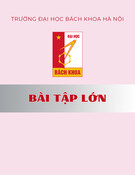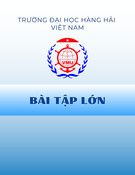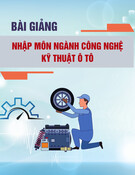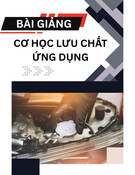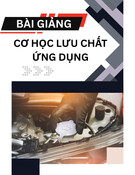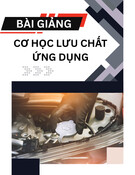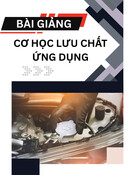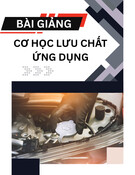DOE-HDBK-1018/2-93
TYPES OF VALVES
Valves
Simpo PDF Merge and Split Unregistered Version - http://www.simpopdf.com
Stem seals are accomplished either with packing in a conventional stuffing box or by means of O-ring seals. Some valve manufacturers, particularly those specializing in the handling of corrosive materials, place a stem seal on the inside of the valve so that no material being handled by the valve can come into contact with the valve stem. If a stuffing box or external O-ring is employed, the fluid passing through the valve will come into contact with the valve stem.
Needle Valves
A needle valve, as shown in Figure 20, is used to make relatively fine adjustments in the amount of fluid flow.
The distinguishing characteristic of a needle valve is the long, tapered, needle- like point on the end of the valve stem. This "needle" acts as a disk. The longer part of the needle is smaller than the orifice in the valve seat and passes through the orifice before the needle seats. This arrangement permits a very gradual increase or decrease in the size of the opening. Needle valves are often used as component parts of other, more complicated valves. For example, they are used in some types of reducing valves.
Needle Valve Applications
Figure 20 Needle Valve
fluctuations
components of
Rev. 0
ME-04
Page 33
Most constant pressure pump governors have needle valves to minimize the effects of in pump discharge pressure. Needle valves are also used in some automatic combustion control systems where very precise flow regulation is necessary.
DOE-HDBK-1018/2-93
Valves
Simpo PDF Merge and Split Unregistered Version - http://www.simpopdf.com TYPES OF VALVES
Needle Valve Body Designs
Figure 21 Bar-Stock Instrument Valve
One type of body design for a needle valve is the bar stock body. Bar stock bodies are common, and, in globe types, a ball swiveling in the stem provides the necessary rotation for seating without damage. The bar stock body is illustrated in Figure 21.
Needle valves are frequently used as metering valves. Metering valves are used for extremely fine flow control. The thin disk or orifice allows for linear flow characteristics. Therefore, the number of handwheel turns can be directly correlated to the amount of flow. A typical metering valve has a stem with 40 threads per inch.
ME-04
Rev.0
Page 34
Needle valves generally use one of two styles of stem packing: an O-ring with TFE backing rings or a TFE packing cylinder. Needle valves are often equipped with replaceable seats for ease of maintenance.
DOE-HDBK-1018/2-93
TYPES OF VALVES
Valves
Simpo PDF Merge and Split Unregistered Version - http://www.simpopdf.com
Check Valves
Check valves are designed to prevent the reversal of flow in a piping system. These valves are activated by the flowing material in the pipeline. The pressure of the fluid passing through the system opens the valve, while any reversal of flow will close the valve. Closure is accomplished by the weight of the check mechanism, by back pressure, by a spring, or by a combination of these means. The general types of check valves are swing, tilting-disk, piston, butterfly, and stop.
Swing Check Valves
Figure 22 Swing Check Valve
A swing check valve is illustrated in Figure 22. The valve allows full, unobstructed flow and automatically closes as pressure decreases. These valves are fully closed when the flow reaches zero and prevent back flow. Turbulence and pressure drop within the valve are very low.
Rev. 0
ME-04
Page 35
A swing check valve is normally recommended for use in systems employing gate valves because of the low pressure drop across the valve. Swing check valves are available in either Y-pattern or straight body design. A straight check valve is illustrated in Figure 22. In either style, the disk and hinge are suspended from the body by means of a hinge pin. Seating is either metal-to- metal or metal seat to composition disk. Composition disks are usually recommended for services where dirt or other particles may be present in the fluid, where noise is objectionable, or where positive shutoff is required.
DOE-HDBK-1018/2-93
Valves
Simpo PDF Merge and Split Unregistered Version - http://www.simpopdf.com TYPES OF VALVES
Straight body swing check valves contain a disk that is hinged at the top. The disk seals against the seat, which is integral with the body. This type of check valve usually has replaceable seat rings. The seating surface is placed at a slight angle to permit easier opening at lower pressures, more positive sealing, and less shock when closing under higher pressures.
Swing check valves are usually installed in conjunction with gate valves because they provide relatively free flow. They are recommended for lines having low velocity flow and should not be used on lines with pulsating flow when the continual flapping or pounding would be destructive to the seating elements. This condition can be partially corrected by using an external lever and weight.
Tilting Disk Check Valves
Figure 23 Operation of Tilting Disk Check Valve
The tilting disk check valve, illustrated in Figure 23, is similar to the swing check valve. Like the swing check, the tilting disk type keeps fluid resistance and turbulence low because of its straight-through design.
ME-04
Rev.0
Page 36
Tilting disk check valves can be installed in horizontal lines and vertical lines having upward flow. Some designs simply fit between two flange faces and provide a compact, lightweight installation, particularly in larger diameter valves.
DOE-HDBK-1018/2-93
TYPES OF VALVES
Valves
Simpo PDF Merge and Split Unregistered Version - http://www.simpopdf.com
The disk lifts off of the seat to open the valve. The airfoil design of the disk allows it to "float" on the flow. Disk stops built into the body position the disk for optimum flow characteristics. A large body cavity helps minimize flow restriction. As flow decreases, the disk starts closing and seals before reverse flow occurs. Backpressure against the disk moves it across the soft seal into the metal seat for tight shutoff without slamming. If the reverse flow pressure is insufficient to cause a tight seal, the valve may be fitted with an external lever and weight.
These valves are available with a soft seal ring, metal seat seal, or a metal-to-metal seal. The latter is recommended for high temperature operation. The soft seal rings are replaceable, but the valve must be removed from the line to make the replacement.
Lift Check Valves
A lift check valve, illustrated in Figure 24, is commonly used in piping systems in which globe valves are being used as a flow control valve. They have similar seating arrangements as globe valves.
Figure 24 Lift Check Valve
Rev. 0
ME-04
Page 37
Lift check valves are suitable for installation in horizontal or vertical lines with upward flow. They are recommended for use with steam, air, gas, water, and on vapor lines with high flow velocities. These valves are available in three body patterns: horizontal, angle, and vertical.
DOE-HDBK-1018/2-93
Valves
Simpo PDF Merge and Split Unregistered Version - http://www.simpopdf.com TYPES OF VALVES
Flow to lift check valves must always enter below the seat. As the flow enters, the disk or ball is raised within guides from the seat by the pressure of the upward flow. When the flow stops or reverses, the disk or ball is forced onto the seat of the valve by both the backflow and gravity.
Some types of lift check valves may be installed horizontally. In this design, the ball is suspended by a system of guide ribs. This type of check valve design is generally employed in plastic check valves.
The seats of metallic body lift check valves are either integral with the body or contain renewable seat rings. Disk construction is similar to the disk construction of globe valves with either metal or composition disks. Metal disk and seat valves can be reground using the same techniques as is used for globe valves.
Piston Check Valves
A piston check valve, illustrated in Figure 25, is essentially a lift check valve. It has a dashpot consisting of a piston and cylinder that provides a cushioning effect during operation. Because of the similarity in design to lift check valves, the flow characteristics through a piston check valve are essentially the same as through a lift check valve.
Figure 25 Piston Check Valve
Installation is the same as for a lift check in that the flow must enter from under the seat. Construction of the seat and disk of a piston check valve is the same as for lift check valves.
ME-04
Rev.0
Page 38
Piston check valves are used primarily in conjunction with globe and angle valves in piping systems experiencing very frequent changes in flow direction. Valves of this type are used on water, steam, and air systems.
DOE-HDBK-1018/2-93
TYPES OF VALVES
Valves
Simpo PDF Merge and Split Unregistered Version - http://www.simpopdf.com
Butterfly Check Valves
to the similar
the construction of
Figure 26 Butterfly Check Valve
Butterfly check valves have a seating seating arrangement arrangement of butterfly valves. Flow characteristics through these check valves are similar to the flow characteristics through butterfly valves. Consequently, butterfly check valves are quite frequently used in systems using butterfly valves. the In addition, butterfly check valve body is such that ample space is provided for unobstructed movement of the butterfly valve disk within the check valve body without the necessity of installing spacers.
The butterfly check valve design is based on a flexible sealing member against the bore of the valve body at an angle of 45o. The short distance the disk must move from full open to full closed inhibits the "slamming" action found in some other Figure 26 types of check valves. illustrates the internal assembly of the butterfly check valve.
Because the flow characteristics are similar to the flow characteristics of butterfly valves, applications of these valves are much the same. Also, because of their relatively quiet operation they find application in heating, ventilation, and air conditioning systems. Simplicity of design also permits their construction in large diameters - up to 72 inches.
As with butterfly valves, the basic body design lends itself to the installation of seat liners constructed of many materials. This permits the construction of a corrosion-resistant valve at less expense than would be encountered if it were necessary to construct the entire body of the higher alloy or more expensive metal. This is particularly true in constructions such as those of titanium.
Flexible sealing members are available in Buna-N, Neoprene, Nordel, Hypalon, Viton, Tyon, Urethane, Butyl, Silicone, and TFE as standard, with other materials available on special order.
Rev. 0
ME-04
Page 39
The valve body essentially is a length of pipe that is fitted with flanges or has threaded, grooved, or plain ends. The interior is bored to a fine finish. The flanged end units can have liners of various metals or plastics installed depending upon the service requirements. Internals and fasteners are always of the same material as the liner.
DOE-HDBK-1018/2-93
Valves
Simpo PDF Merge and Split Unregistered Version - http://www.simpopdf.com TYPES OF VALVES
horizontally
Butterfly check valves may be installed or vertically with the vertical flow either upward or downward. Care should be taken to ensure that the valve is installed so that the entering flow comes from the hinge post end of the valve; otherwise, all flow will be stopped.
Stop Check Valves
Figure 27 Stop Check Valve
A stop check valve, illustrated in Figure 27, is a combination of a lift check valve and a It has a stem globe valve. which, when closed, prevents the disk from coming off the seat and provides a tight seal to a globe valve). (similar When the stem is operated to the open position, the valve operates as a lift check. The stem is not connected to the disk and functions to close the valve tightly or to limit the travel of the valve disk in the open direction.
Relief and Safety Valves
Relief and safety valves prevent equipment damage by relieving accidental over-pressurization of fluid systems. The main difference between a relief valve and a safety valve is the extent of opening at the setpoint pressure.
ME-04
Rev.0
Page 40
A relief valve, illustrated in Figure 28, gradually opens as the inlet pressure increases above the setpoint. A relief valve opens only as necessary to relieve the over-pressure condition. A safety valve, illustrated in Figure 29, rapidly pops fully open as soon as the pressure setting is reached. A safety valve will stay fully open until the pressure drops below a reset pressure. The reset pressure is lower than the actuating pressure setpoint. The difference between the actuating pressure setpoint and the pressure at which the safety valve resets is called blowdown. Blowdown is expressed as a percentage of the actuating pressure setpoint.
DOE-HDBK-1018/2-93
TYPES OF VALVES
Valves
Figure 28 Relief Valve
Simpo PDF Merge and Split Unregistered Version - http://www.simpopdf.com
Relief valves are typically used for incompressible fluids such as water or oil. Safety valves are typically used for compressible fluids such as steam or other gases. Safety valves can often be distinguished by the presence of an external lever at the top of the valve body, which is used as an operational check.
Rev. 0
ME-04
Page 41
As indicated in Figure 29, system pressure provides a force that is attempting to push the disk of the safety valve off its seat. Spring pressure on the stem is forcing the disk onto the seat. At the pressure determined by spring compression, system pressure overcomes spring pressure and the relief valve opens. As system pressure is relieved, the valve closes when spring pressure again overcomes system pressure. Most relief and safety valves open against the force of a compression spring. The pressure setpoint is adjusted by turning the adjusting nuts on top of the yoke to increase or decrease the spring compression.
DOE-HDBK-1018/2-93
Valves
Figure 29 Safety Valve
Simpo PDF Merge and Split Unregistered Version - http://www.simpopdf.com TYPES OF VALVES
Pilot-Operated Relief Valves
ME-04
Rev.0
Page 42
Pilot-operated relief valves are designed to maintain pressure through the use of a small passage to the top of a piston that is connected to the stem such that system pressure closes the main relief valve. When the small pilot valve opens, pressure is relieved from the piston, and system pressure under the disk opens the main relief valve. Such pilot valves are typically solenoid- operated, with the energizing signal originating from pressure measuring systems.
DOE-HDBK-1018/2-93
TYPES OF VALVES
Valves
Simpo PDF Merge and Split Unregistered Version - http://www.simpopdf.com
Summary
The following important information in this chapter is summarized below.
Types of Valves Summary
Gate valves are generally used in systems where low flow resistance for a fully open valve is desired and there is no need to throttle the flow.
Globe valves are used in systems where good throttling characteristics and low seat leakage are desired and a relatively high head loss in an open valve is acceptable.
Ball valves allow quick, quarter turn on-off operation and have poor throttling characteristics.
Plug valves are often used to direct flow between several different ports through use of a single valve.
Diaphragm valves and pinch valves are used in systems where it is desirable for the entire operating mechanism to be completely isolated from the fluid.
Butterfly valves provide significant advantages over other valve designs in weight, space, and cost for large valve applications.
Check valves automatically open to allow flow in one direction and seat to prevent flow in the reverse direction.
A stop check valve is a combination of a lift check valve and a globe valve and incorporates the characteristics of both.
Rev. 0
ME-04
Page 43
Safety/relief valves are used to provide automatic overpressurization protection for a system.
DOE-HDBK-1018/2-93
Valves
Simpo PDF Merge and Split Unregistered Version - http://www.simpopdf.com VALVE ACTUATORS
VALVE ACTUATOR S
Some type of actuator is necessary to allow for the positioning of a valve. Actuators vary from simple manual handwheels to relatively complex electrical and hydraulic manipulators.
EO 1.6
DESCRIBE the construction and principle of operation for the following types of valve actuators:
a. b. c. d. e.
Manual Electric motor Pneumatic Hydraulic Solenoid
Introduction
Valve actuators are selected based upon a number of factors including torque necessary to operate the valve and the need for automatic actuation. Types of actuators include manual handwheel, manual lever, electrical motor, pneumatic, solenoid, hydraulic piston, and self-actuated. All actuators except manual handwheel and lever are adaptable to automatic actuation.
Manual, Fixed, and Ha mmer Actuators
Manual actuators are capable of placing the valve in any position but do not permit automatic operation. The most common type mechanical actuator is the handwheel. This type includes handwheels fixed to the stem, hammer handwheels, and handwheels connected to the stem through gears.
Handwheels Fixed to Stem
Figure 30 Fixed Handwheel
illustrated fixed to only
ME-04
Rev. 0
Page 44
in Figure 30, As the stem handwheels provide the mechanical advantage of the wheel. When these valves are exposed to high operating temperatures, valve binding makes operation difficult.
DOE-HDBK-1018/2-93
VALVE ACTUATORS
Valves
Simpo PDF Merge and Split Unregistered Version - http://www.simpopdf.com
Ha mmer Handwheel
Figure 31 Hammer Handwheel
As illustrated in Figure 31, the hammer handwheel moves freely through a portion of its turn and then hits against a lug on a secondary wheel. The secondary wheel is attached to the valve stem. With this arrangement, the valve can be pounded shut for tight closure or pounded open if it is stuck shut.
Gears
Figure 32 Manual Gear Head
the valve when
Rev. 0
ME-04
Page 45
If additional mechanical advantage is necessary for a manually-operated valve, the valve bonnet is fitted with manually-operated gear heads as illustrated in Figure 32. A special wrench or handwheel attached to the pinion shaft permits one individual to two operate individuals might be needed without the gear advantage. Because several turns of the pinion are necessary to produce one turn of the valve stem, the operating time of large valves is exceptionally The use of long. portable air motors connected to the the valve pinion shaft decreases operating time.

